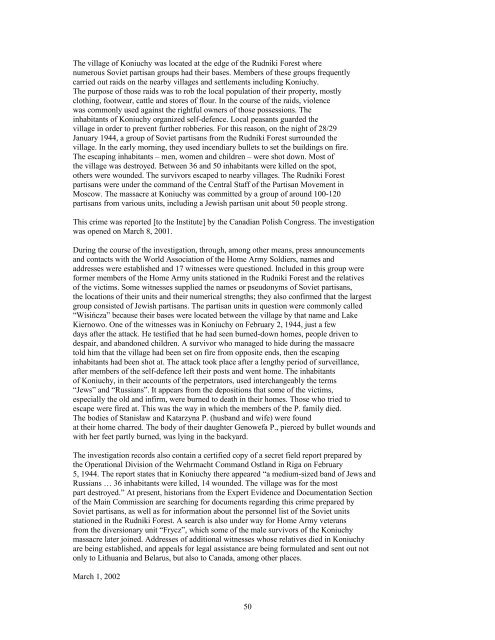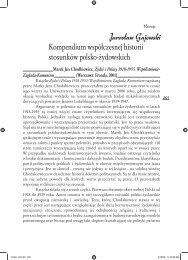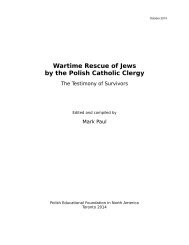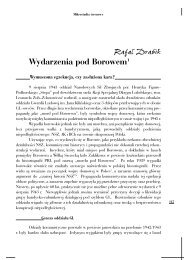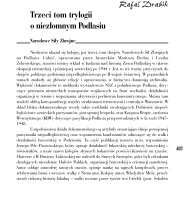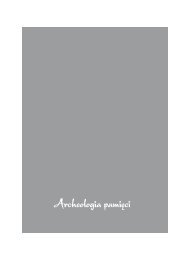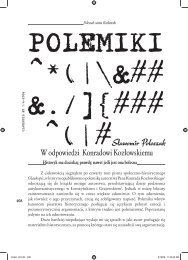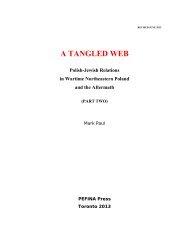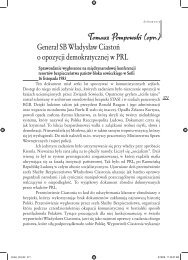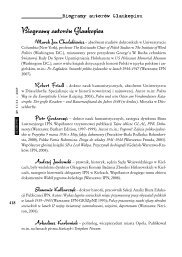THE MASSACRE AT KONIUCHY - Glaukopis
THE MASSACRE AT KONIUCHY - Glaukopis
THE MASSACRE AT KONIUCHY - Glaukopis
You also want an ePaper? Increase the reach of your titles
YUMPU automatically turns print PDFs into web optimized ePapers that Google loves.
The village of Koniuchy was located at the edge of the Rudniki Forest wherenumerous Soviet partisan groups had their bases. Members of these groups frequentlycarried out raids on the nearby villages and settlements including Koniuchy.The purpose of those raids was to rob the local population of their property, mostlyclothing, footwear, cattle and stores of flour. In the course of the raids, violencewas commonly used against the rightful owners of those possessions. Theinhabitants of Koniuchy organized self-defence. Local peasants guarded thevillage in order to prevent further robberies. For this reason, on the night of 28/29January 1944, a group of Soviet partisans from the Rudniki Forest surrounded thevillage. In the early morning, they used incendiary bullets to set the buildings on fire.The escaping inhabitants – men, women and children – were shot down. Most ofthe village was destroyed. Between 36 and 50 inhabitants were killed on the spot,others were wounded. The survivors escaped to nearby villages. The Rudniki Forestpartisans were under the command of the Central Staff of the Partisan Movement inMoscow. The massacre at Koniuchy was committed by a group of around 100-120partisans from various units, including a Jewish partisan unit about 50 people strong.This crime was reported [to the Institute] by the Canadian Polish Congress. The investigationwas opened on March 8, 2001.During the course of the investigation, through, among other means, press announcementsand contacts with the World Association of the Home Army Soldiers, names andaddresses were established and 17 witnesses were questioned. Included in this group wereformer members of the Home Army units stationed in the Rudniki Forest and the relativesof the victims. Some witnesses supplied the names or pseudonyms of Soviet partisans,the locations of their units and their numerical strengths; they also confirmed that the largestgroup consisted of Jewish partisans. The partisan units in question were commonly called“Wisińcza” because their bases were located between the village by that name and LakeKiernowo. One of the witnesses was in Koniuchy on February 2, 1944, just a fewdays after the attack. He testified that he had seen burned-down homes, people driven todespair, and abandoned children. A survivor who managed to hide during the massacretold him that the village had been set on fire from opposite ends, then the escapinginhabitants had been shot at. The attack took place after a lengthy period of surveillance,after members of the self-defence left their posts and went home. The inhabitantsof Koniuchy, in their accounts of the perpetrators, used interchangeably the terms“Jews” and “Russians”. It appears from the depositions that some of the victims,especially the old and infirm, were burned to death in their homes. Those who tried toescape were fired at. This was the way in which the members of the P. family died.The bodies of Stanisław and Katarzyna P. (husband and wife) were foundat their home charred. The body of their daughter Genowefa P., pierced by bullet wounds andwith her feet partly burned, was lying in the backyard.The investigation records also contain a certified copy of a secret field report prepared bythe Operational Division of the Wehrmacht Command Ostland in Riga on February5, 1944. The report states that in Koniuchy there appeared “a medium-sized band of Jews andRussians … 36 inhabitants were killed, 14 wounded. The village was for the mostpart destroyed.” At present, historians from the Expert Evidence and Documentation Sectionof the Main Commission are searching for documents regarding this crime prepared bySoviet partisans, as well as for information about the personnel list of the Soviet unitsstationed in the Rudniki Forest. A search is also under way for Home Army veteransfrom the diversionary unit “Frycz”, which some of the male survivors of the Koniuchymassacre later joined. Addresses of additional witnesses whose relatives died in Koniuchyare being established, and appeals for legal assistance are being formulated and sent out notonly to Lithuania and Belarus, but also to Canada, among other places.March 1, 200250


